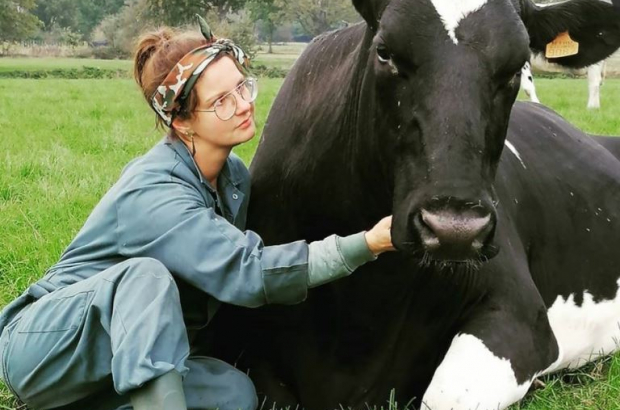- Daily & Weekly newsletters
- Buy & download The Bulletin
- Comment on our articles
Cow cuddling is the perfect moo-d booster
If you’re looking for a therapist who is a great listener, Iris is naturally gifted. She is calm, consoling and non-judgmental. Her clinic may be a hay-strewn stable on a farm in northern Flanders, but Iris also allows patients to hug her, stroke her neck and even lie down on her warm, hairy belly.
Iris is, of course, a cow. She does typical cow activities like being milked, grazing and chewing the cud. But she also moonlights as a human mood-booster, offering her services to visitors who want to indulge in the new wellness trend of cow cuddling.
Cow cuddling is exactly as it sounds. People visit farms to spend a few hours snuggling cattle. In Dutch, it is called koe knuffelen.
Why do it? Mainly because it is so unusual, according to Ben Versteynen, who organises cow cuddling sessions from his farm in Ravels, Antwerp province, on the border with the Netherlands. “People get an experience that they wouldn’t have normally,” he says. “They don’t always know what will happen, but they find that just being close to these creatures can really boost the mood. Cows can be very relaxing.”
The bovine touch
Cow cuddling fits in with other creature fashions like goat yoga. Cows have a slower heartbeat than humans, and at 39 degrees, a higher body temperature. When we hug, our bodies produce oxytocin, also known as the cuddle hormone, which helps us to feel relaxed. Hence the feelgood vibes.
Some 50 people turned up for a Saturday afternoon session at Versteynen’s farm last month, many giggling nervously at the prospect of getting hands-on with a heifer. They were all given overalls and boots before they stepped into cow territory: there is the constant risk of stepping in a pile of freshly laid manure when one wanders among the herd.
All the cows have names. “Iris is the sweetest, always pushing to meet me,” Versteynen says. “ZZ Top is a loner. Silly and Sandra the crazy ones. I can recognise each of them immediately from 100 metres away, and going back five generations.”
Versteynen explains that his “ladies” like to be stroked and scratched under chin, like cats. He advises visitors to approach them from the front so they can be seen. And if the cows lies down on the hay or grass, you can just lean against their belly. “The cows are quiet and gentle,” Versteynen says. “They don’t moo unless they’re stressed, hungry or horny.”
Soon enough, the visitors all find cows to cuddle and take selfies with. I also took the bull by the proverbial horns, finding a 600kg cow whose warm belly pulsated like a giant, hairy beanbag. It was a zen moment – although the serenity was eventually interrupted by another cow who decided to lick my hair, slobbering into my hoodie.
The three-hour sessions that Versteynen and his wife, Marianne, give includes a tour of the stables to explain life on a dairy farm. They have 260 cattle including 140 dairy cows. The milking station is automated: robot machines use electronic eyes to clamp the pumps on to the teats. The average dairy cow has two milking sessions a day, providing some 32 litres of milk, but after birth that can rise to four sessions, yielding up 60 litres a day.
Each cow is fitted with sensors and electronics, and they are only allowed in the paddock after they have been milked. The technology also checks the milk for any infections, texting Versteynen if something comes up. Most cows line up patiently for the robot, but some are pushed out by alpha cows. “It’s like at school: the cows fight sometimes over who is dominant. They also fight over grazing spots. It’s typical in nature,” Versteynen says.
Next to the milking station is a cow cleaning machine, like the whirling brushes in car washes, which Versteynen says is mainly to help brush off mud that cows find itchy. As he says, it’s important that the cows are happy. “My philosophy is that if I take care of the cows, the cows take care of me,” he says.
The farm tour also takes in trip to see the calves, some born just days earlier. Visitors are invited to feed them, and even let them suck their fingers - a bizarre sensation, as the calves have no teeth. The tour ends with coffee and the freshest of milk – plus a thick yoghurt dessert made on site.
More than milking
The farm has been in the Versteynen family for more than a century, and Ben, 34, took over from his father a decade ago. He has a degree in agriculture and biotechnology.
“There are so many things to know about: economy, biology, psychology. For example, when soya prices went up 25%, it had an impact on me.” His studies help when he has to find the right mix of foodstuffs for the cattle: his farm has 40 hectares of grass and 17 hectares of corn, which he uses for their diet. With margins tightening, cow cuddling can help him balance the books.
But Versteynen has other reasons to offer the tours. “It is an eye opener for people about farming,” he says. “There is less and less understanding about what happens here. After this, people can see what goes into a €1 carton of milk. We work up to 70 hours a week. It is not just about feeding, milking and cleaning up shit.”
Tours are currently taking place for a maximum of 10 people to ensure social distancing between visitors.



















